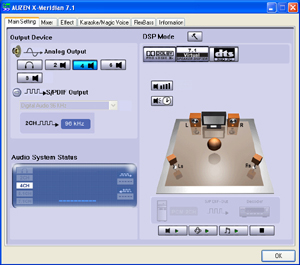
- #Xear Audio Center ダウンロード How To Configure The
- #Xear Audio Center ダウンロード Driver Providing Microsoft
- #Xear Audio Center ダウンロード Install The Device

Xear Audio Center ダウンロード Driver Providing Microsoft
After the download is complete, right-click the zip folder that you downloaded, click Extract All, and complete the instructions. This download contains the Creative Audio Center application providing.Note: Windows usually saves the files to the Downloads folder that is associated with your user account (for example, C:\Users\ your_name\Downloads). The part number and product ID are on the product packaging.This download is a driver providing Microsoft Windows 10 support for Creative.
Xear Audio Center ダウンロード Install The Device
Xear Audio Center ダウンロード How To Configure The
On your keyboard, press the Windows key + X and select Control Panel. After your computer restarts, connect the USB sound card to your computer.Your computer automatically finishes installing the driver and your device should be ready to use.If the USB device does not work after your computer has been in extended hibernation, it is likely that Windows has automatically turned off the USB Root hub to save power.The steps below outline how to configure the USB root hub to stay on during hibernation, to prevent this from happening. Complete the instructions to install the device drivers, and restart your computer when prompted to. Complete the instructions in step 2 to extract the files.
Right-click the first USB Root Hub device and select Properties. Expand Universal Serial Bus controllers by clicking the arrow to the left of it. On your desktop, right-click the My Computer icon and select Properties. Click the Start button and select Control Panel. Click the plus sign (+) next to “USB settings” and “USB selective suspend setting” to expand the options and change the setting to Disabled.Note: You may need to disconnect and re-connect your USB device after applying these settings to re-establish the connection. Click Change plan settings for the plan you want to change.
Ideally, you should test a component that you know works in another setup.When you test your cables, it is recommended that you do the following:When you test the speakers or headsets and sound card, it is recommended that you do the following:Press the Windows key + R, type devmgmt.msc, and press Enter to open Device Manager. You can test to make sure that the following components are working correctly and are not the source of the issue:To test your setup components, try the following:Use the stereo audio cables, speakers or headsets, and sound card in another setup to see if the problem is with the components or the setup.Use a different set of stereo audio cables, speakers or headphones, and sound card in your setup to see if the problem persists. Repeat steps 4-7 for any remaining devices in the Universal Serial Bus Controllers section with “ Root Hub” in the name.When you troubleshoot issues with a sound card, there are some quick tests that you can complete to rule out potential problems.
On the Playback tab, right-click the sound card and click Set as Default Device.To check the default playback device on a computer that is running a version of Windows 8, do the following: In the Default device drop-down menu, click the sound card.To check the default playback device on a computer that is running a version of Windows Vista or Windows 7, do the following:


 0 kommentar(er)
0 kommentar(er)
